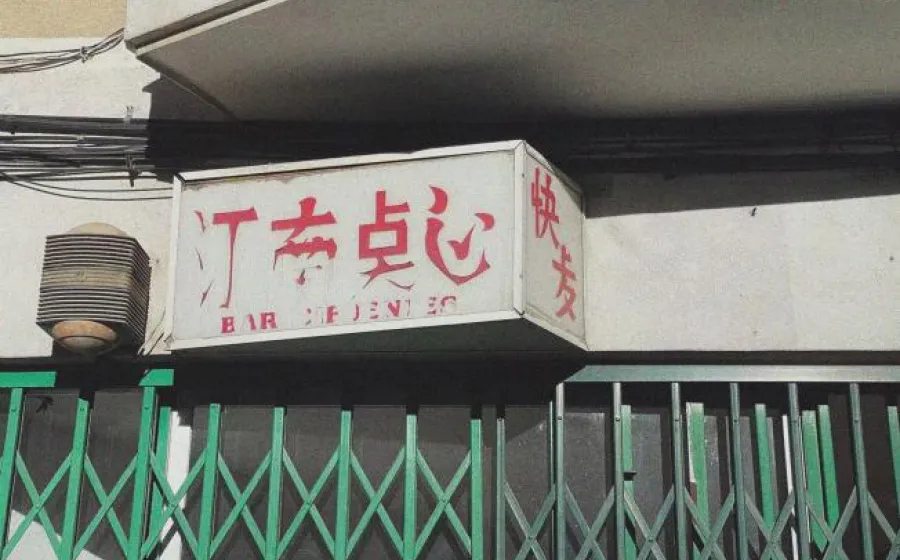Where is my friends_____?
Fecha
Espacio
Categoría
Formato
Institución
Programa
Twenty years ago, almost my entire family lived in Usera. My father owned a game room where people from the Chinese community came to play mahjong and poker.
I spent most of my weekends at 极速网吧 (Jisu Call Center), located on Nicolás Sánchez Street, right below the apartment where my uncles, aunts and all my cousins lived. There, with my friends and siblings, we shared the only time I could speak Chinese and play with other Chinese kids.
For me, as for many children of that time, Usera was a meeting place where we could just be us without being insulted or ridiculed. At that time, there were hardly any Chinese restaurants. I remember a video rental store where I could buy or rent movies and books in Chinese; it was on Dolores Barranco Street. Today, that video rental store is a flower shop.
Twenty years later, Usera has changed. Now it barely belongs to us. It has become a theme park where many people go to enjoy "unique experiences" in Chinese restaurants. Nowadays, you can find food from almost everywhere in China, but when I was a child, all the restaurants served food from Qingtian y Wenzhou, where almost 70% of the Chinese community comes from. At that time, Usera wasn't just a touristy ‘Madrid’s Chinatown’ branding project; it was home. From those memories Where is my friends_____?, an archive of memory and resistance, is born.
It is a photobook that captures everyday life as a political act in the leisure, cultural, and religious spaces—both indoors and outdoors—created by the Chinese diaspora in Usera. The project is born from this contrast between what was lived and what was lost: between that Usera where childhood was a shelter and this present where the neighborhood becomes a production design. It is a look within oneself, but also at memory, migration, celebration, and pride.
In Buddhist temples, mahjong parlors, and Chinese hairdressing saloons, silence and laughter are both narrated. Meeting is already an act of resistance; keeping the language, food, or everyday gestures alive is a form of preserving our memories and reimagining home. These spaces become archives, refugees, homes, and political territories.
Many of these places, invisible to the (white) public gaze, are intimate territories where memory and resistance intertwine with everyday life.
In contrast to stories that exoticize, folklorize, or erase the Chinese presence in Madrid, this project suggests a look from within: slow, complicit, full of pride and tenderness. A look that listens, that observes the details —a table full of customs, a prayer in two languages— and that seeks to recognize the political beauty of the day-to-day.
As a visual artist, interior designer, and anti-racist transfeminist activist, I am interested in how our migrant communities build their own spaces through affective, functional, and symbolic logic. This work builds up from a question that I have had since my early childhood:
How do you spend your free time when the public space doesn't always belong to you?
In the streets where racism disguises itself as tourist curiosity, in the neighborhoods where the markets turn memory into scenery, the communities create their own meeting points. Places where language doesn't need translation, where the body can rest without being looked at, where we can enjoy ourselves without being the otherness.
Where is my friends_____? is also an archive of uncomfortable memories: an attempt to preserve what the city tends to erase. In times of gentrification and touristification, when Usera presents itself as an exotic "Chinatown" for visual consumption, this project restores centrality to the lives that have sustained the neighborhood since the 1990s.
Lives that have been displaced, silenced, but that continue to weave community through food, prayer, play, laughter, and tenderness.
The book combines photography, text, and testimony to construct a collective narrative, where each image and word is a form of resistance. It is an invitation to look without appropriating, listen without translating, understand that memory is not just recollection, but also a political tool to demand justice and belonging.
It is a book that will be built by inviting the Chinese community to narrate in the first person.
A self-managed project that functions as a living archive and community feedback space. It seeks not only to document, but also to activate processes of mutual recognition, strengthen bonds, and open up conversations about how to live and come together in the city.
Yuan iuan
Yuan iuan is a Chinese migrant, queer rights activist, anti-racist campaigner, and visual artist specialising in spatial design. Working at the intersection of art, memory and social justice, he is particularly interested in the migrant experience, the construction of territory, and the creation of spaces in which community resistance can flourish. Combining photography, writing, oral archives, and editorial design, his projects activate processes involving collective memory and challenge the prevalent prejudice towards Chinese people in Spain. A former member of the 8M Madrid Anti-Racist Commission, he is actively involved in Asian diaspora organisations in Spain and is an activist for the Chinese queer collective, Queering All. He has undertaken projects dealing with migrant memory and cultural identity as a form of resistance, most notably his artistic research into the chattels of the diaspora. He is currently working on a book on everyday practices within safe spaces in neighbourhoods such as Usera.

